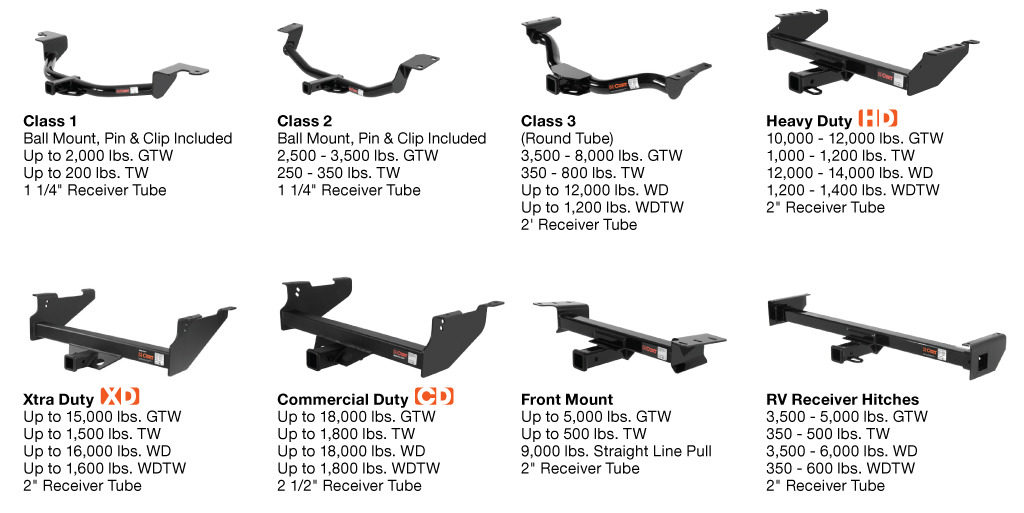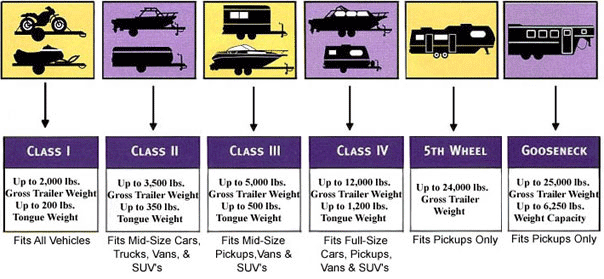By definition, towing hitches are devices that are attached to the chassis of a vehicle for towing.
There are different types of trailer tow hitches that are used in different locations and situations to tow damaged or broken trailers. A trailer hitch can take the form of a tow ball for optimal swiveling and articulation of the towed trailer, a tow pin, a tow hook with a trailer loop; this is mostly in large and agricultural machinery where the slack in the pivot pin allows equal trailer movements.
What are the types of trailer hitches?
Trailer tow hitches are classified according to the maximum Gross Trailer Weight (GTW), the size of the receiver tube and the size of the tow ball. The trailer tow classification list of basic styles of hitches includes;
1. Class I
- These trailer tow hitches are for relatively light towing loads that do not exceed GTW of 2000 pounds or 910 kg. Their receiver tubes are 1 1⁄4 in (31.8 mm)
- They have a maximum trailer tongue weight of 200 lbs (way more than enough for a trailer hitch flag pole)
- They only use drawbars and hitch balls which are of the equal rating or higher
- Most of these hitches are attached to the vehicle frame, but there are some that are attached to the bumper, or truck bed of the vehicle

2. Class II
- These are still for lightweights (GTW) of less than 3500 pounds or 1,600 kg with receiver tubes of 1 1⁄4 in (31.8 mm) receiver tube
- Maximum trailer tongue weight (TW) of 300 lbs
- This class is designed for medium loads towed by small to large sized vehicles.
- They use drawbars and hitch balls of the equal rating or higher
- The hitches are normally attached to the vehicle frame and or solid bumper bumper
3. Class III
- These hitches are made and designed for large loads on trucks and SUVs
- Weight carrying (WC) and weight distributing (WD) hitches depending on the vehicle and specifications of the hitch. The receiver tube is 2 in (50.8 mm)
- Gross weight carrying rated is a maximum of 5000 lbs. or 2300 kg and TW of 500 lbs. They can be used as camper trailer hitches
- Hitches used for weight distributing are up to a GTW of 10,000 lbs. with a Tongue Weight of 1000 lbs.
- They use ball mounts and hitch balls of the equal rating or higher
- These hitches attached to the vehicle frame only
4. Class IV
- Some of these can be both weight carrying (WC) and weight distributing (WD) hitches depending on the hitch specifications and the vehicle. However, take note that not all Class IV hitches are rated to be both WC and WD
- Their weight carrying is rated at a maximum of 12,000 lbs. or 4500 kg GTW with a maximum trailer tongue weight (TW) of 1200 lbs. The WD hitches are rated up to 15,000 lbs. gross trailer weight with a maximum trailer tongue weight of 1500 lbs. The receiver tube is 2 in (50.8 mm)
- The use of ball mounts and hitch balls of the equal rating or higher
- When a weight distribution system is required, it uses the weight distribution side of the hitch
- This class of hitches attaches to the vehicle frame only.
5. Class V
- These are heavy-duty trailer hitches that vary by the weight ratings and use 2-1/2″ hitch receiver.
- They are weight carrying (WC) and weight distributing (WD) hitches.
- Weight carrying is up to 13,000 lbs. GTW with a maximum TW of 1300 lbs.
- The weight distributing hitches are rated up to 17,000lbs or 7700kg GTW, with a maximum trailer TW of 1700lbs.
- They use a ball mount and hitch ball of the same rating or higher
- If a weight distribution system is required then use the weight distribution side of the hitch
- These hitches attach to the vehicle frame only.

Other types of trailer hitches are the Bumper hitches, Front mount hitches, and also specialized hitches that include; weight distribution hitches and fifth wheel hitches.
5th Wheel Hitches
The fifth wheel hitches are heavy-duty hitches that are mounted into the truck bed right over or just forward of the rear axle. Basically, these hitches are for car haulers, large campers, and travel trailers. The most unique feature of the 5th wheel hitches is that their coupling devices act as parts of the hitches and not the trailer itself. The hitches connect to the king-pins from the trailers, and then the hitches secure themselves with a jaw-like mechanism. Fifth wheel hitches are not only for trailers but also available for pickup trucks. Another interesting feature of fifth wheel hitches is that they have a pivot capability which enables them to absorb bumps and move comfortably with the contours of the uneven road. Their tow capacity weight (GTW) is 24,000 lbs. but are advised to double check their specifications before use.
Weight Distribution Hitches
Despite that weight distribution hitches mounting are to the rear hitch of a vehicle, they are still categorized as hitch or hitch attachments. The major purpose of a weight distribution hitch is distributing of the tongue weight across or between the tow vehicle and the trailer. The main feature of a weight distribution hitch is the use of long rods; the spring rods, which offer leverage on the connection point. The rods take a bit of the tongue weight off and redistribute it to other system’s part hence taking off the weight from the rear of the tow vehicle to have better steering. The 5th wheel hitches are commonly used with camping recreation vehicles (RVs).
Word of Caution
Towing can turn to be very risky and dangerous if the correct procedures are not followed. You should always double check your vehicle and load weight ratings, and carefully understand the content of the manuals on anything you are towing.
Summing Up
When selecting the best trailer hitch from the many types of trailer hitches you should consider factors such as the weight capacity of what to tow, the safety of the hitch, the design, where to attach the hitch at the right height , and the type of your vehicle.
In the five classes of towing hitches, each class is specifically designed for a specific trailer weight range. So, when selecting your most appropriate hitch, always make sure that the weight rating of the hitch is higher than the loaded weight of the trailer or trailers to be towed. Obviously, the tow vehicle capacity for weight carrying and the hitch attachment will always vary and will contribute to the class of hitch which should be used.
